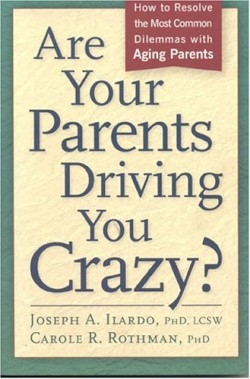Are Your Parents Driving You Crazy?
How to Resolve the Most Common Dilemmas with Aging Parents
“My father can no longer drive safely, but he refuses to stop.”
“My mother moved in with us, and it’s not working.”
“My brother and sister won’t help take care of Mom and Dad.”
Coping with elderly parents who are rational and competent, but less than reasonable about their problems, is not an easy task, and the emotion-laden patterns of family interaction, built up over decades, die hard. An impasse over what should be done can leave one feeling frustrated, helpless, anxious, and maybe even angry.
Although it may not be possible to get parents to agree to a suggestion, Ilardo and Rothman show how relationships can grow and be strengthened by effective communication that clarifies the wishes and concerns of all involved.
Ilardo, a clinical social worker, and Rothman, a clinical psychologist, are both on the faculty of the City University of New York, specializing in family dynamics and communication. They also co-direct the Center for Caregiver Studies and the Center for Adult Children of the Elderly in Scarsdale, New York. Their experience with aging parents has led them to believe that even situations that seem hopeless can be resolved, in ways that allow everyone to “save face.”
The authors offer the acronym “S.U.R.V.I.V.E.” to those trying to help elderly parents adjust to limitations imposed by illness or normal aging: Stay calm; Utilize resources; Respect one’s own limits; Verbalize honestly; Include parents when making plans; Value one’s own feelings; and Expect, and plan ahead for, difficulties.
Using examples of common situations, Ilardo and Rothman present a plan that helps the reader first to identify, then to clarify, a problem, by asking such questions as: “Does everyone agree that a problem exists?” “How urgent is the problem?” “What is behind a parent’s problematic behavior?” “What is ‘hooking’ the one trying to help?” “Who must be included in the discussion?” “What is the goal?”
Solving the problem involves listing the needs that must be satisfied, coming up with a few possible solutions, then analyzing these and choosing one. The authors then suggest doing a “Murphy’s Law” analysis before deciding how to carry out the plan. Evaluation must follow, to see how the plan is, or is not, helping.
At the back of the book are problem-solving worksheets and a helpful list of elder care resources.
Reviewed by
Kristine Morris
Disclosure: This article is not an endorsement, but a review. The publisher of this book provided free copies of the book to have their book reviewed by a professional reviewer. No fee was paid by the publisher for this review. Foreword Reviews only recommends books that we love. Foreword Magazine, Inc. is disclosing this in accordance with the Federal Trade Commission’s 16 CFR, Part 255.

